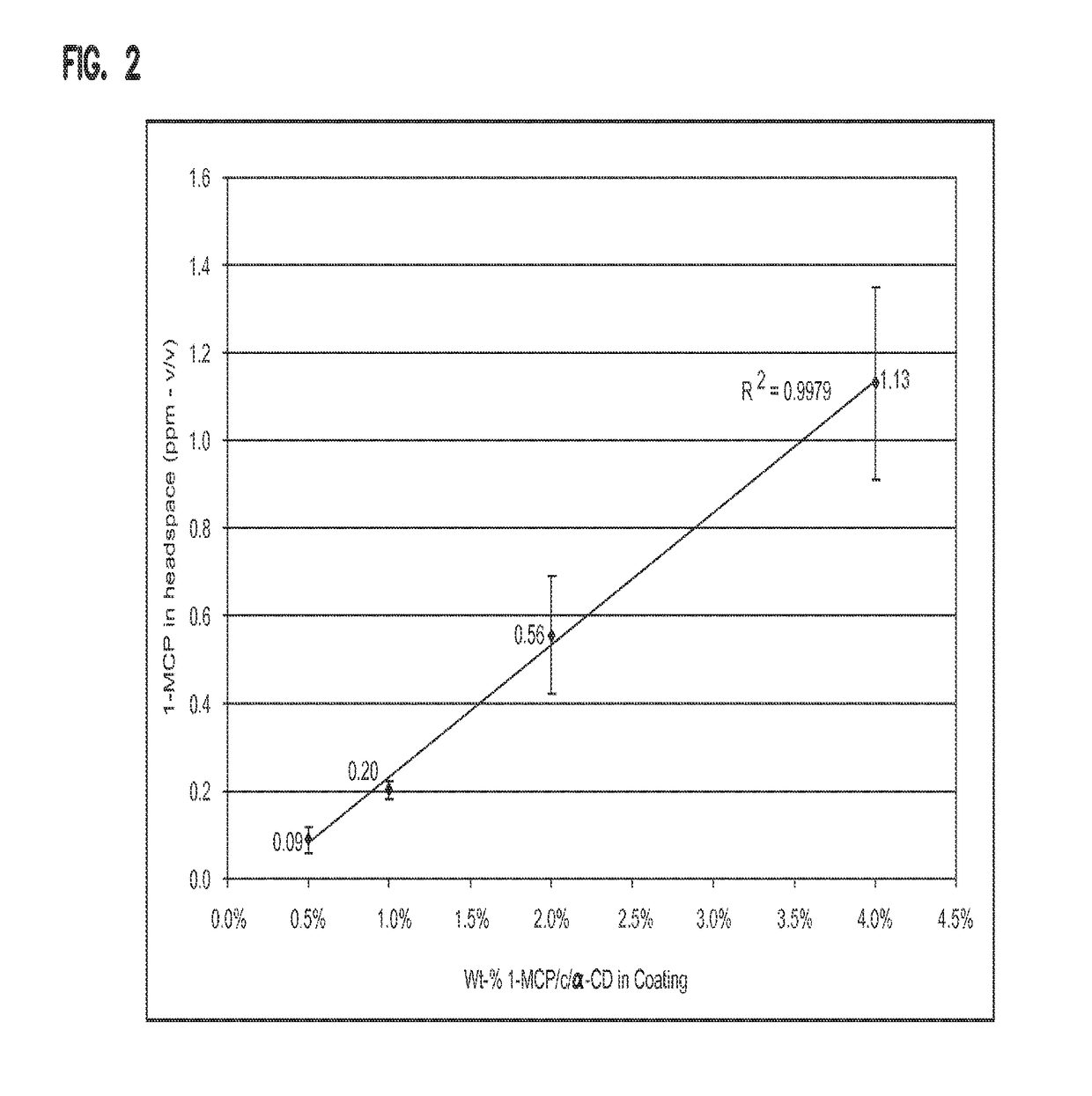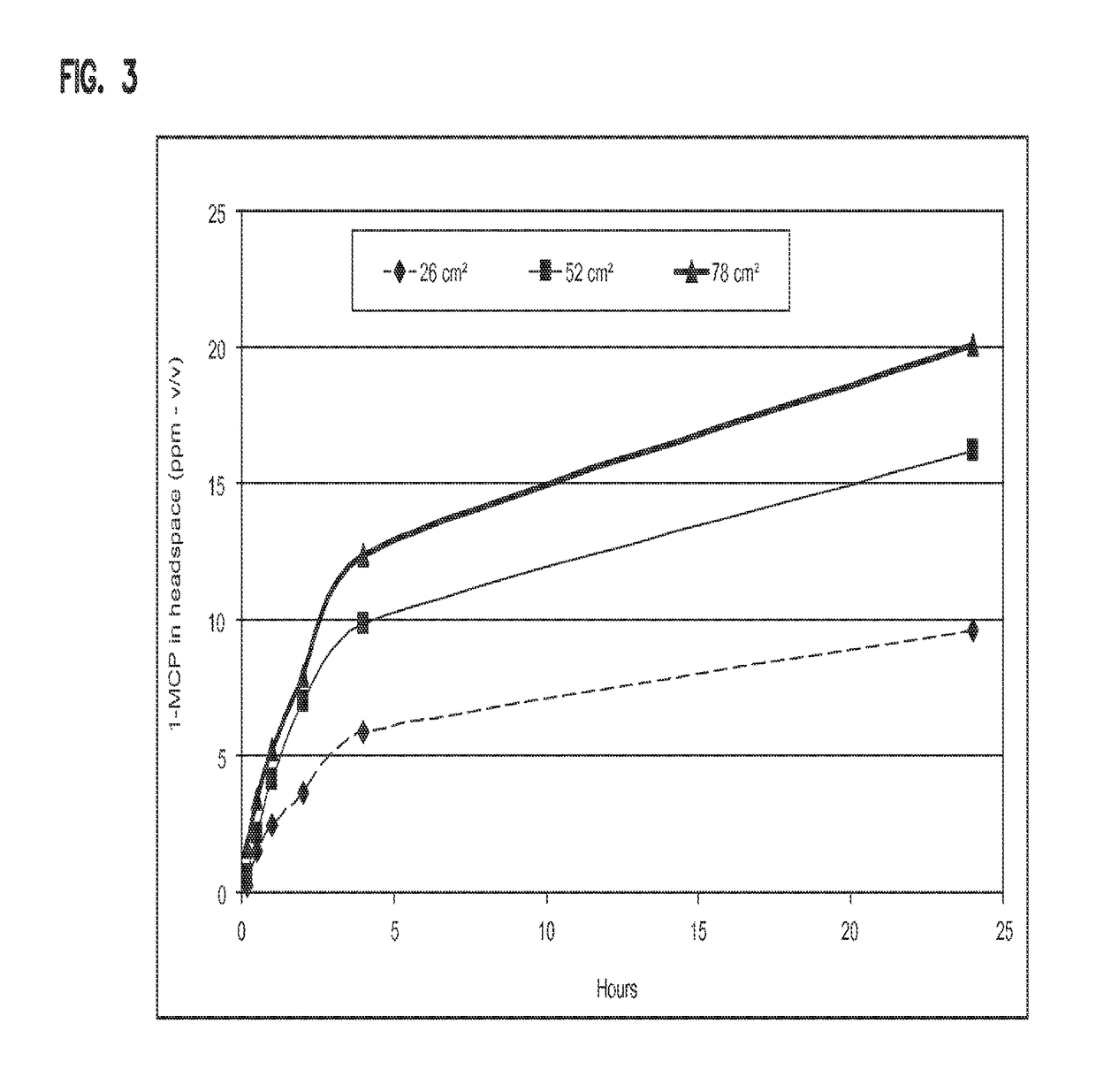Cyclodextrin compositions, articles, and methods
a technology of cyclodextrin and composition, applied in the field of cyclodextrin compositions, articles, and methods, can solve the problems of physiological disorders shortening shelf life and quality, significant reducing post harvest shelf life, and reducing inhibition longer term
- Summary
- Abstract
- Description
- Claims
- Application Information
AI Technical Summary
Benefits of technology
Problems solved by technology
Method used
Image
Examples
example 1
[0094]A cyclodextrin inclusion complex is formed from α-cyclodextrin and 1-methyl cyclopropene (1-MCP) using the technique described by Neoh, T. L. et al., J. Agric. Food Chem. 2007, 55, 11020-11026 “Kinetics of Molecular Encapsulation of 1 Methylcyclopropene into α-Cyclodextrin.” The inclusion complex is termed “1-MCP / c / α-CD.” A 500 mL bottle is charged with 97.0 g of isobornyl acrylate, 1.0 g of hexanediol diacrylate, 1.0 g of 1-MCP / c / α-CD, and 1.0 g of 1-hydroxycyclohexyl benzophenone (IRGACURE® 184, obtained from Ciba Specialty Chemicals Corp. of Tarrytown, N.Y.). The bottle is firmly capped and the components are mixed by shaking the bottle briefly by hand.
[0095]About 2 mL of the mixture is removed with a metered dropper and dispensed on an 8.5 inch by nch PET film and drawn down using a metering rod (Mayer rod) having a delivered coating thickness of 25 microns. Then the coated PET film is placed on a flat surface approximately 5 cm beneath a medium pressure mercury arc lamp o...
example 2
[0098]An inclusion complex of 1-butene and a-cyclodextrin was formed using the technique described by Neoh, T. L. et al., J. Agric. Food Chem. 2007, 55, 11020-11026 “Kinetics of Molecular Encapsulation of 1-Methylcyclopropene into α-Cyclodextrin” except that 1-butene (99.0% pure, Scott Specialty Gases, Plumsteadville, Pa.) was bubbled through a saturated α-cyclodextrin solution instead of 1-MCP. A precipitate was formed during the process, which was collected by filtering through a 10 micron fritted filter, and dried at ambient temperature at 0.1 mm Hg for about 24 hours. The inclusion complex was termed “1-butene / c / α-CD.”
[0099]1-butene / c / α-CD was analyzed by adding 100 mg of the collected and dried precipitate to a 250 mL glass bottle equipped with a septum cap, taking care to ensure that no powder adheres to the walls of the bottle. After about 1 hour, 250 μL of headspace gas was removed from the bottle using a six port, two-position gas sampling valve (Valco #EC6W) interfaced dir...
example 3
[0105]A 20 mL bottle was charged with 9.6 g of UV Coating VP 10169 / 60 MF-2NE (obtained from Verga GmbH of Aschau am Inn, Germany). Then 0.4 g of 1-MCP / a-cyclodextrin complex (4.7% 1-MCP obtained from AgroFresh of Spring House, Pa.) termed “1-MCP / c / α-CD” was added to the bottle. The bottle was then firmly capped and shaken by hand by hand until the blends appear uniformly dispersed, resulting in a 4.0 wt-% 1-MCP / c / α-CD blend. Three additional blends containing 2.0 wt-%, 1.0 wt-% and 0.5 wt-% of 1-MCP / c / α-CD were prepared in the same manner.
[0106]A rubber ink roller was used to deliver a thin (nominally 0.3 μm) coating to a 20 cm by 20 cm polyethylene extrusion coated paper sheet using the technique of Example 2.
[0107]Using razor blade, 2.5 cm×10 cm rectangles were cut from the coated portion of each of the sheets. Then the coated rectangular sheets were cured using the procedure of Example 2. Each cured, coated rectangle was placed in a 250 mL serum bottle. The bottle was then sealed...
PUM
| Property | Measurement | Unit |
|---|---|---|
| Temperature | aaaaa | aaaaa |
| Thickness | aaaaa | aaaaa |
| Thickness | aaaaa | aaaaa |
Abstract
Description
Claims
Application Information
 Login to View More
Login to View More - R&D
- Intellectual Property
- Life Sciences
- Materials
- Tech Scout
- Unparalleled Data Quality
- Higher Quality Content
- 60% Fewer Hallucinations
Browse by: Latest US Patents, China's latest patents, Technical Efficacy Thesaurus, Application Domain, Technology Topic, Popular Technical Reports.
© 2025 PatSnap. All rights reserved.Legal|Privacy policy|Modern Slavery Act Transparency Statement|Sitemap|About US| Contact US: help@patsnap.com



